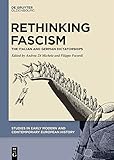Rethinking Fascism : The Italian and German Dictatorships / ed. by Di Michele Andrea, Filippo Focardi.
Material type: TextSeries: Studies in Early Modern and Contemporary European History ; 4Publisher: München ; Wien : De Gruyter Oldenbourg, [2022]Copyright date: ©2022Description: 1 online resource (VI, 335 p.)Content type:
TextSeries: Studies in Early Modern and Contemporary European History ; 4Publisher: München ; Wien : De Gruyter Oldenbourg, [2022]Copyright date: ©2022Description: 1 online resource (VI, 335 p.)Content type: - 9783110766455
- 9783110768633
- 9783110768619
- 320.53/3094 23
- DG571.16 .R48 2022
- DG571.16 .R48 2022
- online - DeGruyter
- Issued also in print.
| Item type | Current library | Call number | URL | Status | Notes | Barcode | |
|---|---|---|---|---|---|---|---|
 eBook
eBook
|
Biblioteca "Angelicum" Pont. Univ. S.Tommaso d'Aquino Nuvola online | online - DeGruyter (Browse shelf(Opens below)) | Online access | Not for loan (Accesso limitato) | Accesso per gli utenti autorizzati / Access for authorized users | (dgr)9783110768619 |
Frontmatter -- Contents -- Introduction -- I. Fascism and Nazism in a Transnational Key -- German Historiography on National Socialism in Its Transnational Context -- Roberta Pergher Italian Fascism in Transnational Historiography -- II. “Volksgemeinschaft” and the Relationship between Italian Society and Fascism -- From Debates on the Political Order to Visions of Community -- Beyond Consensus: Rethinking Italian Fascism -- III. The Dictators: Hitler and Mussolini -- Adolf Hitler and Benito Mussolini -- Benito Mussolini: 100 Years on -- Adolf Hitler -- IV. Violence -- “Spaces” of Violence -- Fascist Violence. History and Historiography -- V. Stone Fascism after the War -- Obersalzberg and the Axis -- Traces of Fascist Architecture in Republican Italy -- Fascist Monuments on the Border. The Case of Bolzano/Bozen, South Tyrol -- VI. The New Right and Fascism -- “Sempre Presente?” -- Old Ideologies and New Strategies. German Right-Wing Populism -- CasaPound Italia and Forza Nuova. Back to the Future -- Contributors
restricted access online access with authorization star
http://purl.org/coar/access_right/c_16ec
This book takes up the stimuli of new international historiography, albeit focusing mainly on the two regimes that undoubtedly provided the model for Fascist movements in Europe, namely the Italian and the German. Starting with a historiographical assessment of the international situation, vis-à-vis studies on Fascism and National Socialism, and then concentrate on certain aspects that are essential to any study of the two dictatorships, namely the complex relationships with their respective societies, the figures of the two dictators and the role of violence. This volume reaches beyond the time-frame encompassing Fascism and National Socialism experiences, directing the attention also toward the period subsequent to their demise. This is done in two ways. On the one hand, examining the uncomfortable architectural legacy left by dictatorships to the democratic societies that came after the war. On the other hand, the book addresses an issue that is very much alive both in the strictly historiographical and political science debate, that is to say, to what extent can the label of Fascism be used to identify political phenomena of these current times, such as movements and parties of the so-called populist and souverainist right.
Issued also in print.
Mode of access: Internet via World Wide Web.
In English.
Description based on online resource; title from PDF title page (publisher's Web site, viewed 02. Mai 2023)


